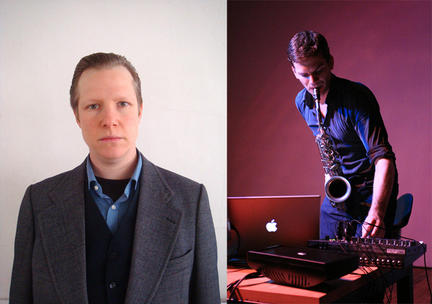No longer uptodate!
After nearly 15 years, this website is being decommissioned. For a while, this old version will still be reachable, but it will no longer show reliable information about events at ausland,
The new version of our website can be found here: https://ausland.berlin
sololala 2009 (4th night)

SOLOLALA 2009
05.12.09
20:00
Alvin Lucier: I am sitting in a room (1970)
performed by Antonia Baehr (D/Berlin)
21:00
Thomas Ankersmit Solo (NL/Berlin)
Alvin Lucier: "I am sitting in a room"
for voice and electromagnetic tape (1970)
Necessary Equipment: One microphone, two tape recorders, amplifier and one loudspeaker.
Choose a room the musical qualities of which you would like to evoke.
Attach the microphone to the input of tape recorder #1.
To the output of tape recorder #2 attach the amplifier and loudspeaker.
Use the following text or any other text of any length:
I am sitting in a room different from the one you are in now.
I am recording the sound of my voice and i am going to play it back in the room again and again until the resonant frequencies of the room reinforce themselves so that any semblance of my speech. with perhaps the exception of rhythm, is destroyed.
What you will hear, then, are the resonant frequencies of the room articulated by speech.
I regard this activity not so much as a demonstration of a physical fact, but more as a way to smooth out any irregularities my speech might have.
Record your voice on tape through the microphone attached to tape recorder #1.
Rewind the tape to its beginning, transfer it to tape recorder #2, play it back into the room through the loudspeaker and record a second generation of the original recorded statement through the microphone attached to tape recorder #1.
Rewind the second generation to its beginning and splice it on to the end of the original recorded statement on tape recorder #1.
Play the second generation only back into the room through the loudspeaker and record a third generation of the original statement through the microphone attached to tape recorder #1.
Continue this process through many generations.
All the generations spliced together in chronological order make a tape composition the length of which is determined by the length of the original statement and the number of generations recorded.
Make versions in which one recorded statement is recycled throught many rooms.
Make versions using one or more spaekers of different languages in different rooms.
Make versions in which, for each generation, the microphone is moved to different parts of the room or rooms.
Make versions which can be performed in real time.
[Original Prose Score taken from "Alvin Lucier: Reflections", Edition MusikTexte, 1995, Köln, www.musiktexte.de]
Thomas Ankersmit Solo (NL *1979)
"....when I started playing saxophone I was mostly listening to noise and electroacoustic music, so my ideas about sound and music (as well as what could be done with a saxophone specifically) were shaped by that from the outset. In a way I've played saxophone like this from the beginning, although of course the emphasis has shifted and I've become a little better at it over the years. I've never consciously tried to make the saxophone sound like an electronic instrument, it's just that the sonic language of noise and electronic music was my mental framework for playing an instrument. When I occasionally take notes for particular saxophone techniques I do tend to use electronic music vocabulary; I always define pitches in Hz and think in terms of amplitude and frequency modulation etc." (taken from an interview with Martin Haanstra, Spring 2006, for Paris Transatlatic Magazine)
Antonia Baehr über "I am sitting in a room":
Das Stück ist von 1970. Das ist das Jahr, in dem ich geboren wurde. Wir sind beide bald 40 Jahre alt. Es werden keine Abweichungen zur Fassung von 1970 angestrebt, außer zweien. Die erste: ein technischer Apparat wird sich von Luciers "Verbalnotation" von 1970 unterscheiden. Das Tonband wird hier durch den Computer ersetzt, da dies keinen signifikanten Unterschied im erzielten Ergebnis hervorruft. Die zweite: ich bin nicht Alvin Lucier. Dieser nicht abzuleugnende Unterschied hat insbesondere auf den Schlusssatz Auswirkungen. Lucier: "I regard this activity not so much as a demonstration of a physical fact, but more as a way to smooth out any irregularities my speech might have". Hier bezog sich Lucier auf sein Stottern. Dies ist eine Eigenschaft, die ich nicht besitze. Welche Eigenschaft hat wohl meine gesprochene Stimme, habe ich mich gefragt? Sie ist hoch. Sogar vielleicht besonders hoch. Meine äußere Erscheinung und Kleidung ist männlich. Oft werde ich in Frankreich, wo ich mich zur Zeit am meisten aufhalte, mit "Bonjour Monsieur" angesprochen. Wenn ich "Bonjour" antworte, heißt es daraufhin "Oh pardon! Bonjour Madame!!", mit häufigen Begleiterscheinungen bei der sprechenden Person, wie z.B. Kopfschütteln, Erröten, betretenes Lächeln.
Ich bin gespannt, ob dieses Experiment die Zuschreibungen und geschlechtlichen Adressierungen, die durch das Zusammenspiel von Kleidung und Stimme ausgelöst werden, aufweichen mag.
I am sitting in the same room as the one you are in now.
I am recording the sound of my speaking voice and I am going to play it back into the room again and again until the resonant frequencies of the room reinforce themselves so that any semblance of my speech, with perhaps the exception of rhythm, is destroyed.
What you will hear, then, are the natural resonant frequencies of the room articulated by speech.
I regard this activity not so much as a demonstration of a physical fact, but more as a way to undo the gender attribution the pitch of my speaking voice might produce.


